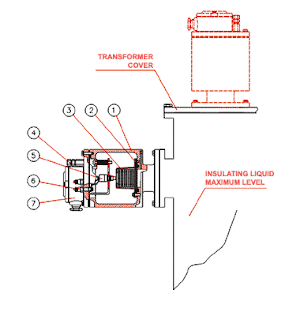A. Relay Bucholz
Relay Bucholz adalah relai yang berfungsi mendeteksi dan mengamankan terhadap gangguan transformator yang menimbulkan gas.
Timbulnya gas dapat diakibatkan oleh beberapa hal, diantaranya adalah:
• Hubung singkat antar lilitan pada atau dalam phasa
• Hubung singkat antar phasa
• Hubung singkat antar phasa ke tanah
• Busur api listrik antar laminasi
• Busur api listrik karena kontak yang kurang baik.
B. Relai Tekanan Lebih (Sudden Pressure Relay)
Relai ini berfungsi hampir sama seperti Relay Bucholz. Fungsinya adalah mengamankan terhadap gangguan di dalam transformator. Bedanya relai ini hanya bekerja oleh kenaikan tekanan gas yang tiba-tiba dan langsung mentripkan pemutus tenaga (PMT). Alat pengaman tekanan lebih ini berupa membran yang terbuat dari kaca, plastik, tembaga atau katup berpegas, sebagai pengaman tangki transformator terhadap kenaikan tekan gas yang timbul di dalam tangki yang akan pecah pada tekanan tertentu dan kekuatannya lebih rendah dari kekuatan tangki transformator
Berikut ini adalah gambar dari Rele Tekanan Lebih
1. Relay body
2. Equalizer
3. Metal bellows
4. Manual relief valve
5. Microswitch
6. Connection terminals
7. Terminal box
C. Relai Diferensial
Berfungsi mengamankan transformator terhadap gangguan di dalam transformator, antara lain adalah kejadian flash over antara kumparan dengan kumparan atau kumparan dengan tangki atau belitan dengan belitan di dalam kumparan ataupun beda kumparan.
D. Relai Arus lebih (Over Current Relay)
Berfungsi mengamankan transformator jika arus yang mengalir melebihi dari nilai yang diperkenankan lewat pada transformator tersebut dan arus lebih ini dapat terjadi oleh karena beban lebih atau gangguan hubung singkat. Arus lebih ini dideteksi oleh transformator arus atau current transformator (CT).
E. Relai Tangki Tanah
Alat ini berfungsi untuk mengamankan transformator bila ada hubung singkat antara bagian yang bertegangan dengan bagian yang tidak bertegangan pada transformator.
F. Relai Hubung Tanah
Fungsi alat ini adalah untuk mengamankan transformator jika terjadi gangguan hubung singkat satu phasa ke tanah.
G. Relai Thermis
Alat ini berfungsi untuk mencegah/mengamankan transformator dari kerusakan isolasi pada kumparan, akibat adanya panas lebih yang ditimbulkan oleh arus lebih. Besaran yang diukur di dalam relai ini adalah kenaikan suhu.
H. Rele beban lebih
Rele ini berfungsi untuk mengamankan trafo terhadap beban yang berlebihan dengan menggunakan sirkuit simulator yang dapat mendeteksi lilitan trafo yang kemudian apabia terjadi gangguan akan membunyikan alarm pada tahap pertama dan kemudian akan menjatuhkan PMT.
I. Rele fluks lebih
Rele ini berfungsi untuk mengamankan transformator dengan mendeteksi besaran fluksi atau perbandingan tegangan dan frekwensi.
READ MORE - Peralatan Pengaman Pada Trafo
Relay Bucholz adalah relai yang berfungsi mendeteksi dan mengamankan terhadap gangguan transformator yang menimbulkan gas.
Timbulnya gas dapat diakibatkan oleh beberapa hal, diantaranya adalah:
• Hubung singkat antar lilitan pada atau dalam phasa
• Hubung singkat antar phasa
• Hubung singkat antar phasa ke tanah
• Busur api listrik antar laminasi
• Busur api listrik karena kontak yang kurang baik.
B. Relai Tekanan Lebih (Sudden Pressure Relay)
Relai ini berfungsi hampir sama seperti Relay Bucholz. Fungsinya adalah mengamankan terhadap gangguan di dalam transformator. Bedanya relai ini hanya bekerja oleh kenaikan tekanan gas yang tiba-tiba dan langsung mentripkan pemutus tenaga (PMT). Alat pengaman tekanan lebih ini berupa membran yang terbuat dari kaca, plastik, tembaga atau katup berpegas, sebagai pengaman tangki transformator terhadap kenaikan tekan gas yang timbul di dalam tangki yang akan pecah pada tekanan tertentu dan kekuatannya lebih rendah dari kekuatan tangki transformator
Berikut ini adalah gambar dari Rele Tekanan Lebih
1. Relay body
2. Equalizer
3. Metal bellows
4. Manual relief valve
5. Microswitch
6. Connection terminals
7. Terminal box
C. Relai Diferensial
Berfungsi mengamankan transformator terhadap gangguan di dalam transformator, antara lain adalah kejadian flash over antara kumparan dengan kumparan atau kumparan dengan tangki atau belitan dengan belitan di dalam kumparan ataupun beda kumparan.
D. Relai Arus lebih (Over Current Relay)
Berfungsi mengamankan transformator jika arus yang mengalir melebihi dari nilai yang diperkenankan lewat pada transformator tersebut dan arus lebih ini dapat terjadi oleh karena beban lebih atau gangguan hubung singkat. Arus lebih ini dideteksi oleh transformator arus atau current transformator (CT).
E. Relai Tangki Tanah
Alat ini berfungsi untuk mengamankan transformator bila ada hubung singkat antara bagian yang bertegangan dengan bagian yang tidak bertegangan pada transformator.
F. Relai Hubung Tanah
Fungsi alat ini adalah untuk mengamankan transformator jika terjadi gangguan hubung singkat satu phasa ke tanah.
G. Relai Thermis
Alat ini berfungsi untuk mencegah/mengamankan transformator dari kerusakan isolasi pada kumparan, akibat adanya panas lebih yang ditimbulkan oleh arus lebih. Besaran yang diukur di dalam relai ini adalah kenaikan suhu.
H. Rele beban lebih
Rele ini berfungsi untuk mengamankan trafo terhadap beban yang berlebihan dengan menggunakan sirkuit simulator yang dapat mendeteksi lilitan trafo yang kemudian apabia terjadi gangguan akan membunyikan alarm pada tahap pertama dan kemudian akan menjatuhkan PMT.
I. Rele fluks lebih
Rele ini berfungsi untuk mengamankan transformator dengan mendeteksi besaran fluksi atau perbandingan tegangan dan frekwensi.




















